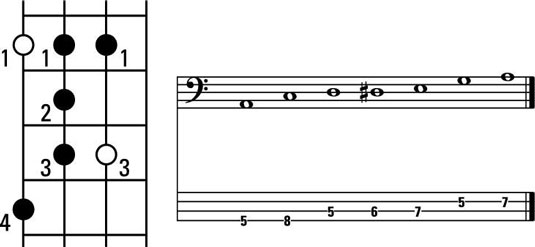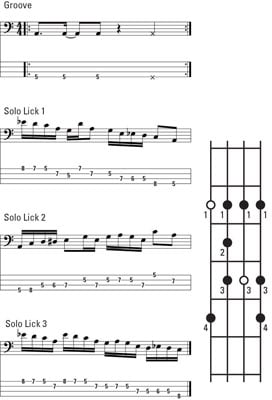The six-note blues scale is one of the most commonly used scales in bass guitar soloing — and with good reason: It’s comfortable to play, it’s easy to move from chord to chord, and it sounds great. The blues scale is a one-size-fits-all scale, no matter what the chord tonality (major, minor, or dominant).
However, as with those one-size-fits-all pieces of clothing, the blues scale doesn’t always give you a perfect fit; you may have to move a note or two by a fret.
When you create a solo with the blues scale, it of course will sound bluesy. Let your ears be the judge of which notes you can linger on and which notes you should use as passing tones (unaccented notes that connect two strong notes). It’s just like salt for the soup: When you add the right amount, it’s delicious; when you use too much, you spoil the broth.
You need three strings to complete the blues scale for one octave, so start on either the E or A string on the root of the chord you’re playing. However, when you’re playing a bass solo, it sounds really nice if you extend into the next octave and use all four strings of your bass for the blues scale licks. The following steps explain how to play a blues scale.

Press the index finger of your left hand down on the root of the chord (on the E or A string) and play the note.
Press your pinkie down on the same string and play the note.
This note is ♭ó3 (flat 3); it’s one of the blue (slightly dissonant) notes.
Press your index finger down on the next higher (thinner) string and play the note.
This note is a 4; it sounds fairly neutral.
Press your middle finger down on the same string and play the note.
This note is a ♯4 (sharp 4); it’s another blue note.
Press your ring finger down on the same string and play the note.
This note is a 5; it’s present in almost all chords.
Press your index finger down on the next higher (thinner) string and play the note.
This note is a ♭ó7 (flat 7); it’s usually a cool choice.
Press your ring finger down on the same string and play the note.
This note is your octave; you’ve arrived at the root again.
Three strings. No shifts. The blues scale couldn’t be easier.
You can use the notes of the blues scale in any order — not just straight up and down. You also can use the blues scale over any chord: major, minor, or dominant. Use the blues scale tastefully and sparingly; don’t overdo it. Pay attention to which notes sound good for any of the chords.
For example, don’t hang on the ♭ó7 when you’re soloing over a major chord; instead, just pass through it and land on the root (that’s just one option).
Check out some useful blues-scale licks. A lick, in this case, doesn’t refer to how your dog welcomes you home. A lick is a short melodic phrase you play in a solo — a solo is a succession of licks. You can collect a repertoire of licks from your favorite musicians, and you also can create some of your own.
Check out Chapter 7, Audio Track 50 to hear what a blues scale (in A) sounds like, followed by three distinctive blues-scale licks (each preceded by a groove). If you start the extended-range blues scale on the E string, you won’t have to shift. You can also see the scales being played in Chapter 7, Video Clip 18.


